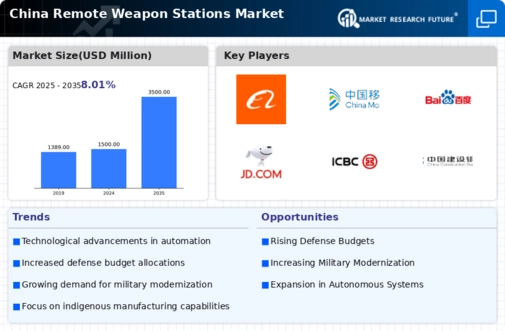Rising Geopolitical Tensions
The remote weapon-stations market in China is experiencing growth due to escalating geopolitical tensions in the Asia-Pacific region. The need for enhanced military capabilities has prompted the Chinese government to invest heavily in advanced defense technologies. This investment is reflected in the 2025 defense budget, which allocates approximately $250 billion to modernization efforts. As regional conflicts become more pronounced, the demand for remote weapon-stations is likely to increase, as they provide strategic advantages in surveillance and engagement. The integration of these systems into existing military frameworks appears essential for maintaining a competitive edge. Consequently, the remote weapon-stations market is poised for expansion as military planners prioritize these technologies to address emerging threats.
Advancements in Automation and AI
The integration of automation and artificial intelligence (AI) into military systems is significantly influencing the remote weapon-stations market in China. The Chinese defense sector is increasingly adopting AI technologies to enhance operational efficiency and decision-making processes. Reports indicate that AI-driven systems can improve targeting accuracy by up to 30%, thereby increasing the effectiveness of remote weapon-stations. This trend suggests a shift towards more autonomous systems, which may reduce the need for human operators in high-risk environments. As the military seeks to leverage these advancements, the remote weapon-stations market is likely to see a surge in demand for AI-enabled platforms, reflecting a broader trend towards modernization and technological sophistication.
Increased Focus on Border Security
China's emphasis on border security is driving the remote weapon-stations market as the government seeks to bolster its defense capabilities along its extensive borders. The Ministry of National Defense has reported a 15% increase in funding for border security initiatives, which includes the deployment of advanced surveillance and weapon systems. Remote weapon-stations are particularly suited for this purpose, as they can be strategically positioned to monitor and respond to potential threats without risking personnel. This focus on securing borders not only enhances national security but also stimulates the remote weapon-stations market, as military planners prioritize investments in these technologies to ensure effective surveillance and rapid response capabilities.
Growing Demand for Enhanced Surveillance
The remote weapon-stations market in China is benefiting from a growing demand for enhanced surveillance capabilities. As security concerns rise, the military is increasingly investing in systems that provide real-time intelligence and situational awareness. Remote weapon-stations equipped with advanced sensors and imaging technologies can monitor vast areas, making them invaluable for both military and civilian applications. The Chinese government has allocated approximately $50 billion for surveillance technology development in 2025, indicating a strong commitment to improving national security. This investment is likely to drive the remote weapon-stations market, as these systems become integral to comprehensive surveillance strategies aimed at addressing various security challenges.
Strategic Partnerships and Collaborations
Strategic partnerships and collaborations between defense contractors and technology firms are shaping the remote weapon-stations market in China. These alliances facilitate the exchange of knowledge and resources, enabling the development of cutting-edge technologies. For instance, collaborations with AI firms have led to innovations in targeting systems, enhancing the effectiveness of remote weapon-stations. The Chinese government encourages such partnerships to foster domestic capabilities and reduce reliance on foreign technologies. As a result, the remote weapon-stations market is likely to experience growth driven by these collaborative efforts, which aim to create advanced systems tailored to the specific needs of the Chinese military.


















Leave a Comment